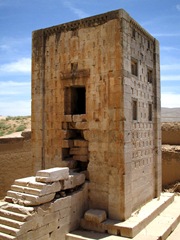
Published by Circle of Ancient Iranian Studies
The measured earth sinkage previously reported by experts was five centimetres, but a new survey shows that this amount has increased over the past few days, the Persian service of the Mehr News Agency reported on Monday.
Experts believe that the occurrence may lead to the destruction of 2500 year-old edifice, which is located at a distance of five meters from the sinking earth.
This also could cause cracks in rocks bearing the ancient bas-reliefs, they surmised.
Drilling numerous wells by the Islamic Republic and consequent reduction in the level of water tables in the region is the main factor causing the catastrophe.
“The earth sinkage may result in a landslide or a rift that could destroy the ancients sites located in the region,” said geologist Hassan Mousavi.
Mousavi believes the unduly draining water from the numerous wells dug close to the site is the main reason for this.
In order to prevent a cultural heritage catastrophe in the region, he suggested that further exploitation of the wells must be stopped until water table levels are restored.
However, number of experts believe the cause of the sinkage is also related to the recently constructed railways road by the Islamic Republic. The Railways is connecting Isfahan to Shiraz is only 1000 meters away from the ancient site and the trains vibrations can easily be felt in Naqsh-e Rostam.
In 2006 experts and cultural institutions including CAIS warned the vibration generate from the passing trains will cause the collapse of the Ka’aba of Zoroaster, and asked the project to be scrapped or transferred to another location away from the ancient sites.
However, like many other development projects in Islamic Iran, the objective is not to develop but to destroy, Islamic Republic went ahead and constructed the railway near the site. The regimes plot was apparent – to ensure the destruction of the K’aba of Zoroaster and other monuments in Naqsh-e Rostam.
Since taking over the power in Iran, the Islamic republic has begun their cultural-cleansing of the pre-Islamic Iranian heritage under the guise of the development projects. The totalitarian-theocratic regime since then has damaged and destroyed large number of major pre-Islamic cultural landmarks.
Islamic Republic is considered to be one of the most destructive, brutal and corrupt regimes has ever ruled over Iran. Their reign of tyranny and terror surpasses the Alexander, Arabs, and Mongols invasion of Iran – and their incompetence to govern and run the country is compared to the Qajars and loss of 17 Iranians provinces in Central Asia and Caucuses, as well as Afghanistan.
The regime runs by mixture of opportunist-corrupts who gathered wealth beyond imagination at the expense of the Iranian nation[1] — or backward-dogmatic Islamic-fundamentalists who hallucinating and seeing ‘halo’ or ‘Shi’a saints’ standing beside them and believe by spreading the rule of terror, hatred, tyranny and pain on earth, they would speed up the return of twelfth Shi’a Imam called Mahdi to earth, in their case ascending from a water well in Jamkaran near Tehran.
Ka’aba of Zoroaster
Located in Iranian Fars province, 12 kilometres from Persepolis, Naqsh-e Rostam contains four tombs belonging to Achaemenid kings which were carved out of the rock. The site also contains remnants of the Elamite, Parthian and Sasanian dynastic eras.
The Ka’aba of Zoroaster along with the Naqsh-e Rostam region is one of the most unique and important sites in Iran-proper.
There are various theories on the original purpose of the monument. Some experts believe that the monument was the home of a complete copy of the Avesta which had been written on 12,000 leather parchments which was burned by Alexander II, the Macedonian warlord in 4th century BCE, it has been suggested that it was a place where the Zoroastrians’ sacred fire was perpetually burning. Others claim that the site was used as an ancient government archive. In 2005, Iranian researcher Reza Moradi Ghiasabadi proposed the structure was a unique calendrical calculations and astronomical building during the Achaemenid dynasty (550-33- BCE).
The structure bears a Sasanian dynastic era inscription explaining the historical events that took place during the reign of the Emperor Shapur I (241-272 CE).
The trilingual inscription, written in the Sasanian and Parthian Pahlavi as well as Greek, describes the victory of Emperor Shapur over the Roman Emperor Valerian in 260 CE.
[1] Islamic Republic ranks 88 out of 158 countries on the "Transparency International’s Corruption Perception Index" (CPI) with a CPI score of 2.9 (a scale of 0 – 10 with 0 being the most corrupt). CNN is recently published a report exposing 60 member of the Islamic Republic who have stolen billions of Iranian’s assets and hidden overseas.
